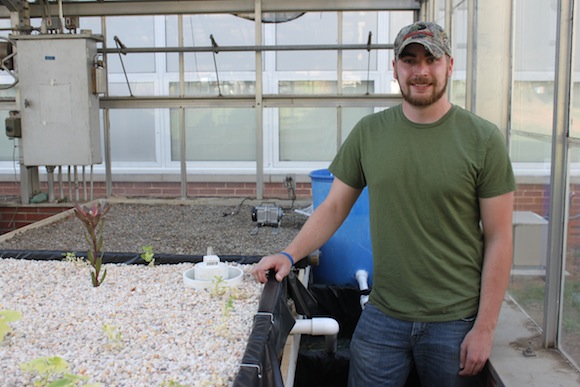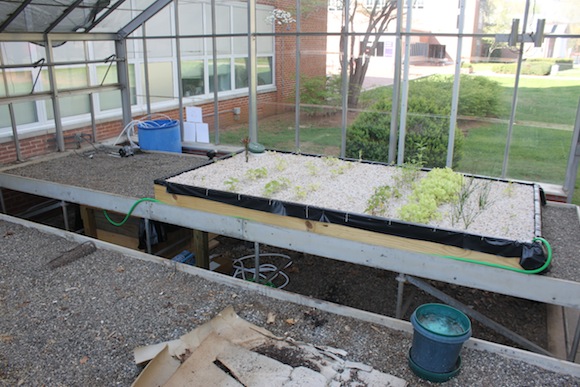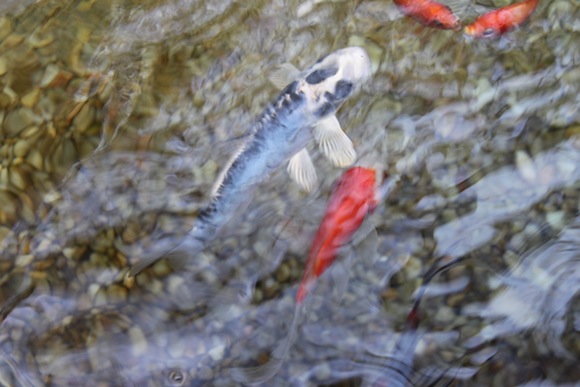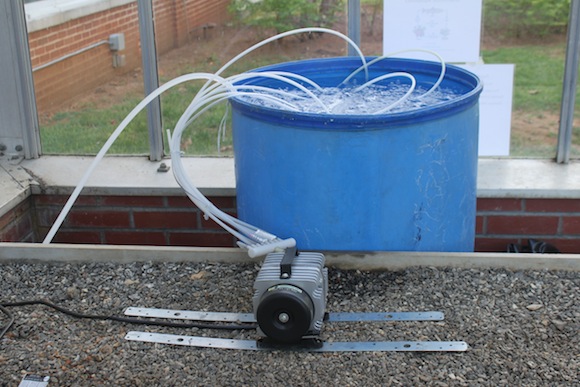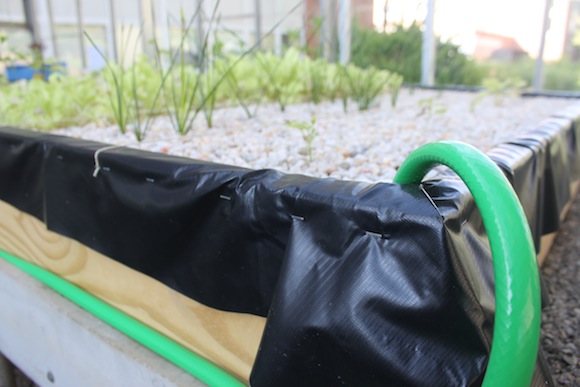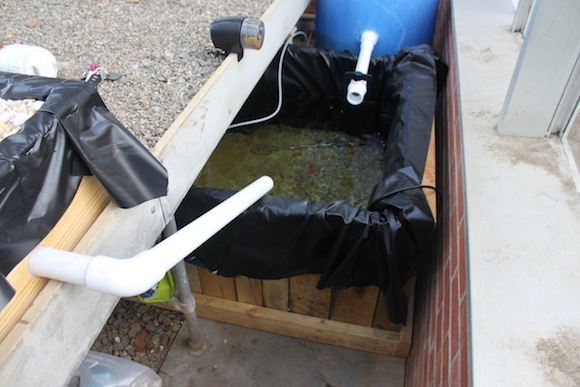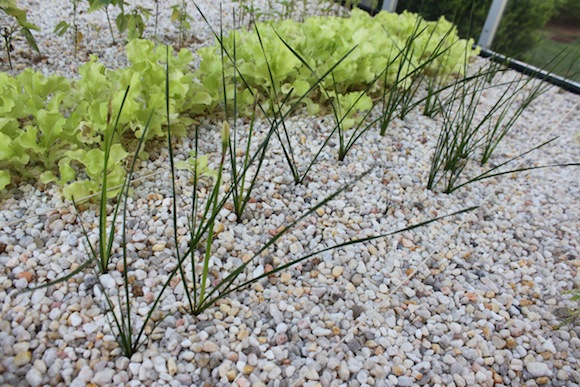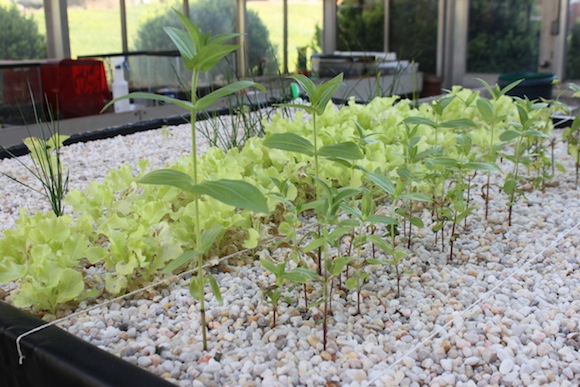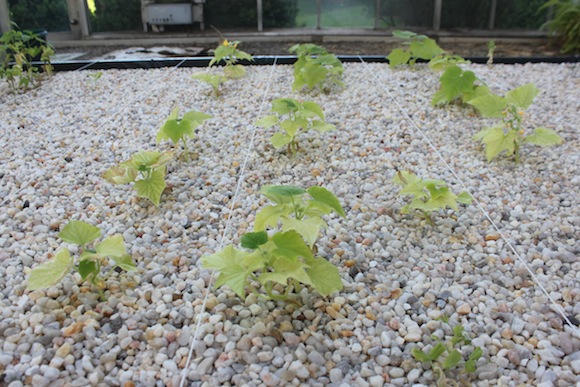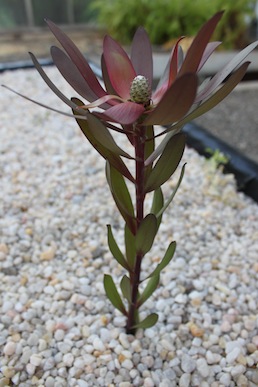Randy Reinke is a new graduate of Western Carolina University with a bachelor of science degree in natural resource conservation and management. He spent his senior year developing a fully functional aquaponic farming system in the WCU campus greenhouse.
What is aquaponics? It is a hybrid of two different farming techniques.
The cultivation of plant life in water is called hydroponics, while the raising of aquatic animals in tanks is known as aquaculture. Aquaponics combines both of these practices to create a symbiotic food production system.
An aquaponic system consists of a water-filled tank containing marine organisms and a bed of growing plant life, with machines that keep the two groups sustained by each other’s biological processes. It allows farmers to grow healthy fish, prawns or crayfish together with vegetation in a very efficient, interconnected setup.
As the aquatic animals live and eat in the water, waste and other effluents accumulate over time. The waste-filled water is transferred through a hose into a bed of soil or gravel.
Bacteria in the bed act as a biofilter by breaking down the harmful nitrogen byproducts in the water while leaving behind the waste nutrients which feed the plants. The water is then siphoned through a filter, cleaned and redistributed back into the marine tank.
Because the plants use marine animal waste as food, there is no need for fertilizers, which can cause dead zones when they enter streams, lakes and oceans. The entire process is designed to have as minimal of a lasting impact on the environment as possible.
“Our current farming practices are destroying our land and our water, so it’s very important that we begin to explore new and more efficient ways to grow our food without the destruction to the environment,” Reinke said.
Reinke first got involved with aquaponics when his neighbor asked for help to build an outdoor aquaponic system. “It captured my interest because while we were building the system, most of the country was experiencing a drought,” Reinke said. “Aquaponics has been recorded as using as little as 10 percent of the water that traditional field crops require.”
After helping his neighbor, Reinke built his own aquaponic system in his apartment. He then asked his university advisor, Dr. Brian Kloeppel, about making a school project out of it. Kloeppel suggested that Reinke build another system in the campus greenhouse.
“I wasn’t sure at first,” Reinke said, “but then I realized it would be a good opportunity for me to use the system as a model for a small business plan and would allow students to see a non-traditional food production method that, if done right, can be much less harmful to our water and soil.”
Reinke got permission to use the greenhouse from Dr. Kathy Mathews, who was more than happy to allot him the space. He then submitted proposals for grants to the Honors College, the Natural Resources Conservation Management Department (NRCM) and the Quality Enhancement Plan (QEP).
Kloeppel proofread the proposals and wrote letters of endorsement saying that he believed the funds would be put to good use and the project would be completed. “I couldn’t have built this system without him,” Reinke said.
Reinke received the grant from the Honors College but was denied the QEP grant. However, the NRCM Department not only approved him for the NRCM enrichment funds but also allocated some of the QEP funds that the department had received this year. Additionally, Dr. Jerry Miller provided money from the Blanton Whitmire Endowment to buy gravel.
Anna Thompson of the Department of Geosciences and Natural Resources and Bonnie Beam of the Honors College helped out by using the grant money to make all of the purchases for Reinke’s system with university credit cards and purchase orders.
Since Reinke did not get the total amount of money he had requested in grants, he got creative and redesigned his aquaponic system to be more cost-effective. He built the fish tank out of reclaimed lumber instead of buying a new one.
When it came time to select fish for his system, Reinke applied for an aquaculture permit for tilapia with the N.C. Department of Agriculture. Though he was approved, Reinke had a difficult time obtaining the fish so he tried to get catfish instead.
Unfortunately, the truck transporting the catfish broke down in transit and it would have been another month before the next delivery, so Reinke opted to go with koi and goldfish. “Although they are not edible, they produce a ton of waste and are great for aquaponic systems,” Reinke said.
Reinke planted vegetables including cucumbers, bell peppers, Cherokee purple tomatoes, peas and lettuce, as well as several wildflowers such as morning glories and Cullowhee lilies. Reinke selected Cullowhee lilies because he hoped it would help draw interest and possibly provide a way to breed them so people can plant them around Cullowhee.
Now that Reinke has graduated, the fate of his aquaponic system in the WCU greenhouse is up in the air. Anja Nothdurft, president of the Campus Kitchen Garden Club, will maintain the system throughout the summer but will not be able to continue with it in the fall.
“I think it would be awesome for students, faculty and the community to get involved,” Reinke said. “I put a lot of hard work into that system and it would be a shame for it to be forgotten about when I leave.”
If you would like to help carry on the legacy of Randy Reinke’s aquaponics endeavor at WCU, send him an email at rareinke1@catamount.wcu.edu.
“I would love to show anyone interested and answer any questions they have,” Reinke said.
